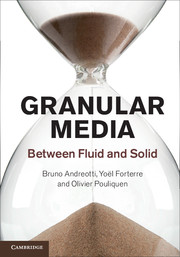5 - Granular gases
Published online by Cambridge University Press: 05 June 2013
Summary
The previous chapters show that a granular medium can behave as a solid. In the opposite limit, when grains are strongly shaken in a box, particles are agitated and interact mainly by binary collisions. The medium is then more similar to a gas. This chapter is devoted to this ‘gaseous’ regime of granular matter. The analogy between agitated grains and molecules in a gas was the basis for the development of kinetic theories of granular media that provide constitutive equations for rapid and diluted granular flows. In this chapter, we first introduce the notion of granular temperature and briefly discuss the analogies and differences between a granular gas and a classical molecular gas (Section 5.1). We then present a first approach to the kinetic theory, which gives insight into the physical origin of the transport coefficients (Section 5.2). A more formal presentation of the kinetic theory that is based on the Boltzmann equation for inelastic gases is given in the next section (Section 5.3). We then apply the hydrodynamic equations of the kinetic theory to various situations that highlight the role of inelastic collisions in the behaviour of granular gases (Section 5.4). Finally, some limits of the kinetic theory are discussed, in particular concerning dense media (Section 5.5).
Analogies and differences with a molecular gas
Figure 5.1 gives two examples of granular materials in a ‘gaseous’ state. The first one is obtained by shaking vertically a box containing beads. The second example shows steel beads flowing down a steeply inclined plane under the action of gravity. In both cases, the medium looks like a gas. Particles are strongly agitated and move independently, except when collisions occur.
- Type
- Chapter
- Information
- Granular MediaBetween Fluid and Solid, pp. 169 - 214Publisher: Cambridge University PressPrint publication year: 2013
- 1
- Cited by



